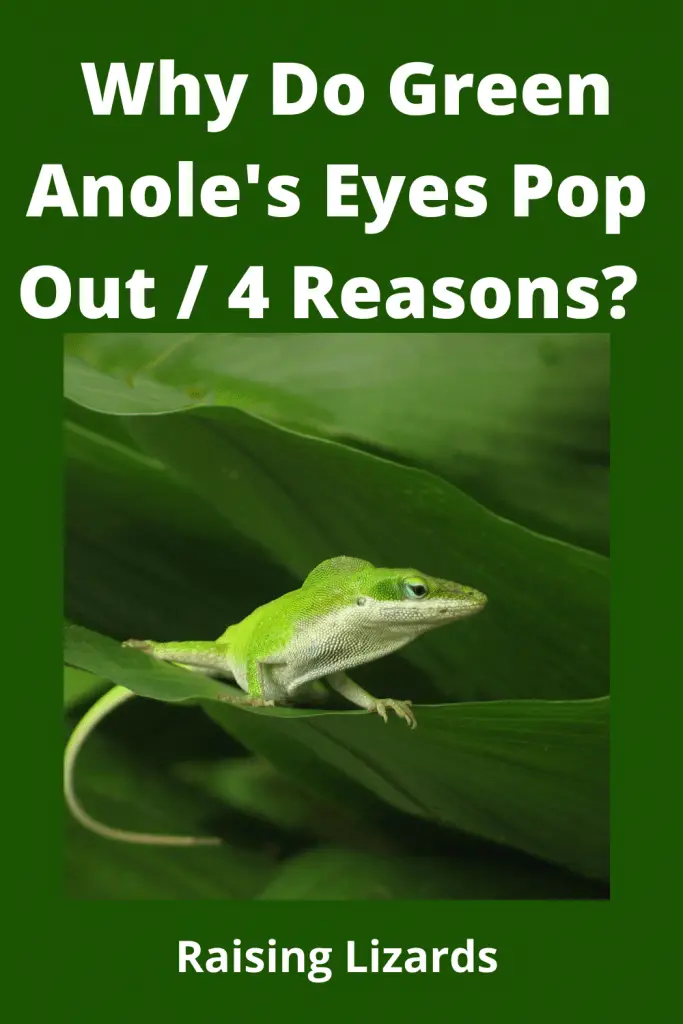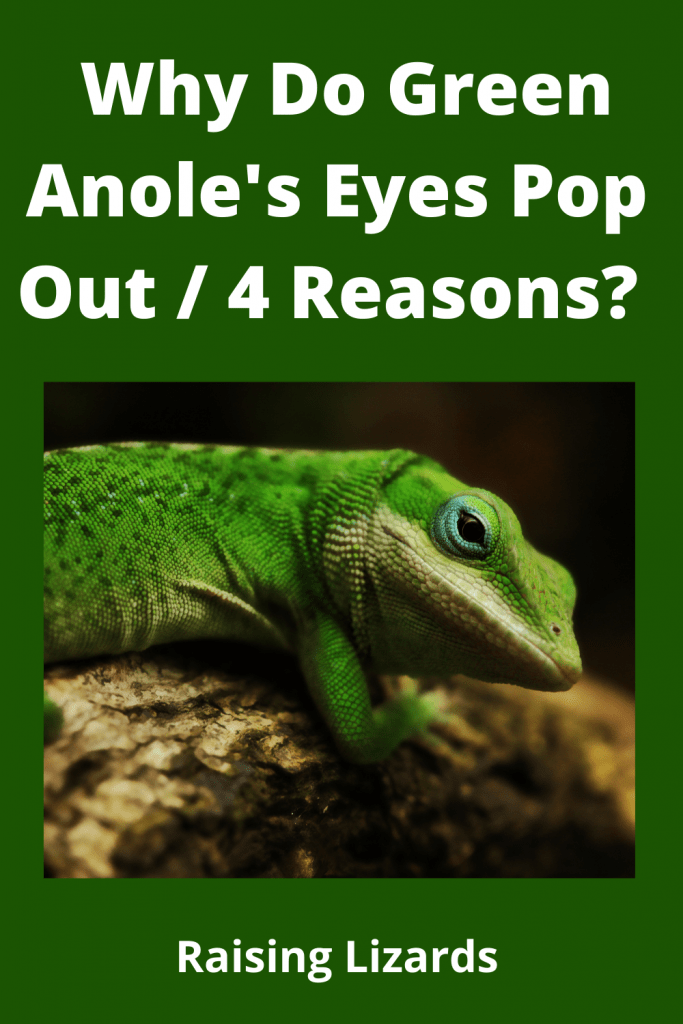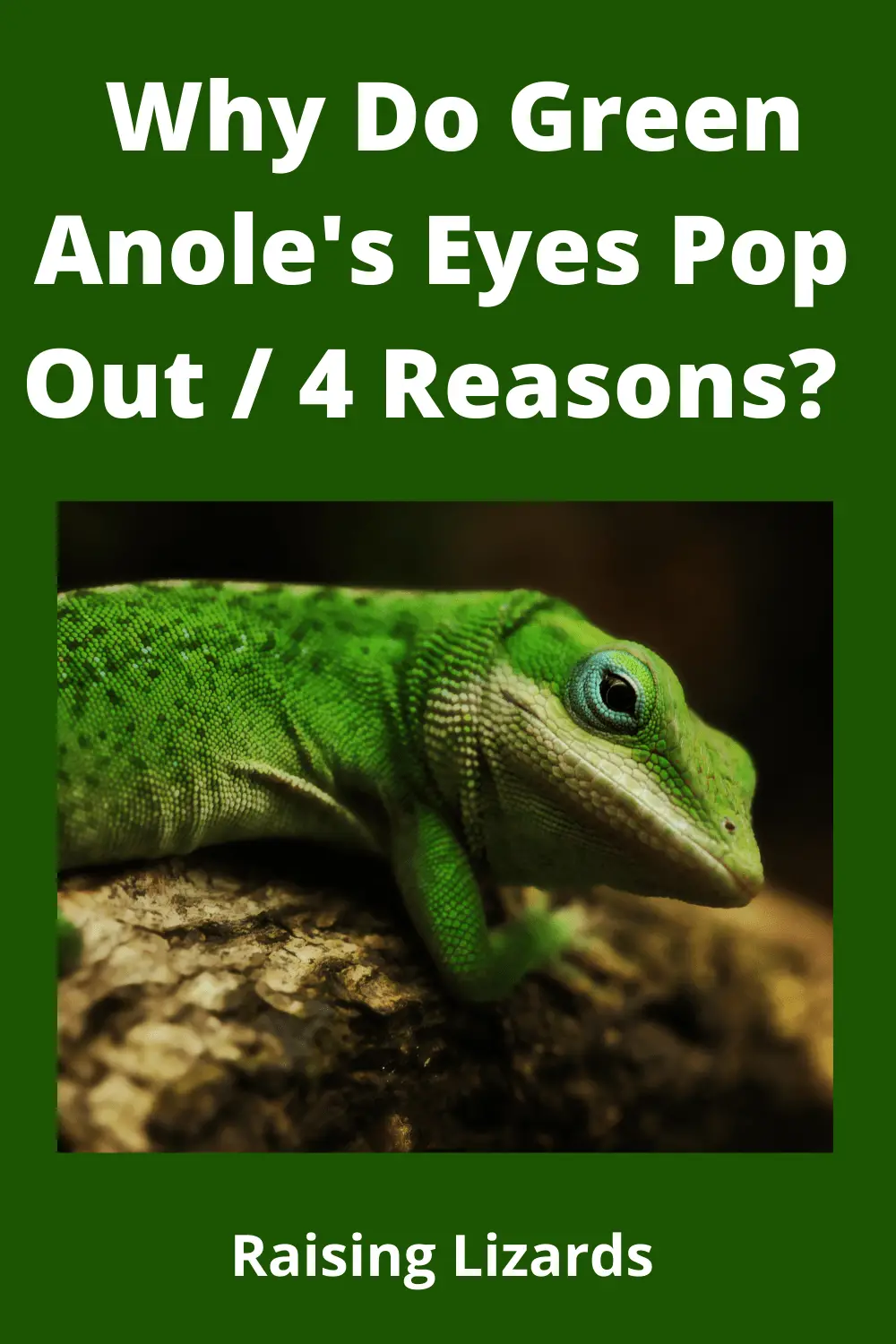What is Wrong My Green Anole’s eyes Pop out?)
Why is my Anole’s Eyes Pop Out? The Green Anole is a small to medium-sized lizard with a slim body. The head is big, pointed, and long with ridges between the nostrils and eyes, and smaller ridges on the top of the head. Adhesive pads are present on toes to facilitate climbing. They show sexual dimorphism; the males are usually fifteen percent larger. Jump to Anole Eggs – Do Anoles Lay Unfertilized Eggs?
The male dewlap, which is bright red, also known as throat fin, is three times the size of the female’s fin, is prominent in the breeding season, whereas that of the female is lighter in color, ranging from pearl white to pale pink. Males can enlarge a pronounced dorsal ridge that is present behind the head when displaying or when they are under stress. Females possess a prominent white stripe running along their spine, a feature absent in most males.
The Colour of Green Anole varies from brown to green and can be changed like many other kinds of lizards, but green anoles are near related to iguanas and are not true chameleons.
Why do Green Anole’s Eyes Pop Out?
There are many reasons for puffed out or pop out eyes in green anoles. It may be physiological or anticipated due to seasonal activity of shedding skin or maybe pathological due to some injury, bacterial or parasitical infection. All of the possibilities are described below.
Normal Physiological phenomena:
Puffed out Eyelids (Pre-Shed):
This is common in many lizards with moveable eyelids, seen most frequently in iguanas and green anoles.

As the skin present on the eyelids is undergoing the changes related to, i.e., getting ready to shed, the Green Anole will puff out its eyelids mostly when its eyes are closed. These bulge out eyes look terrifying from the outside, but they help loosen the old skin layer, readying it to shed.
At a certain point in the pre-shed period, you may walk in to find your green anole has suddenly converted into some bug-eyed monster. Lying silently, its closed eyes are puffed out 2-3 times their standard size. This is quite natural and normal. They are puffing them up with air to loosen the old skin.
Later, when the old skin is ready to shatter and start coming off, the lizards will often stroke/rub their closed eyes against something in their cage or area. This might be to soothe and to remove itch related to the coming shed or might be done to help smoothly break the skin so that the final step in the shedding process can start, that stage where you lizard looks like it has bits of cloth stuck to its eyelids, waving smoothly in the breeze. Gentle and smooth head rubs, with your thumb and finger sliding over the closed lids, are particularly welcomed at this time.
Pre-Shed Indicators
Before a shed, you will notice that the green anole starts to change colors. The green anole overall color will get dimmer, duller. The patches will appear first in the front of the head, then back, arms, and tail, as the different areas get closer to shedding. Typically, green anoles start shedding at their heads, with the sequence going down the body, limbs, and finally, tail. Everything comes off, over their ears, over the eyes, including the skin.
If you bathe regularly or do not spray your green anole with water or spray, then you may face a shedding problem. You may want to do this during the pre-shed and shed period. In the wild, the natural moisture in the air and free access to rivers and canals help keep old skin soft and supple as it exfoliates. In our arid captive environment, loose pieces of skin can dry out very quickly, resulting in prolonged growth. So, it’s essential to take that point into account when you have a pet Green Anole. Expensive vitamin and moisturizing sprays are unnecessary and no better than plain water or a simple spray bottle.

Puffed out eyelids/eyes due to shedding is mostly referred to as a regular physiological seasonal change in green anoles
If you pull off to shed the skin that isn’t ready to come off, you will indeed cause mites. You won’t afford to cause mites to your Green Anoles. The mites aren’t created out of thin air. However, pulling off the skin before it is ready to slough off can damage the underlying and not entirely formed keratinous scales growing in place on the new skin layer, present beneath the old layer. This may also injure the new skin layer, and mites always look for the least resistance path when looking for a blood meal. Very thin or defective (injured) skin provides less resistance to their mouthparts than the thickened skin with its protective covering of keratinous scales.
The only way for your Green Anole to “get” mites if you forcefully pull of skin that isn’t yet ready to come off, plus your Green Anole’s environment, is already infested with mites. There may be a minimal number of mites you haven’t noticed yet, but given the optimal environmental conditions and easy access to food, they will multiply with a vast amount. If there are no mites in the environment, then their infestation may be minimal, but in that case, too, you never should peel off the shedding layer from your Green Anoles.
Pathological conditions:
There are many conditions in which eyes bulge out, which are not expected, so the owner must take care of that in the account.
They are:
- Parasites
The problems caused by parasites seldom cause swelling or tearing, but there will always be a chance. Mites find the surrounding area of the eye of spectacled lizard species like Green Anoles to be quite welcoming. The widespread problems caused by mites leads to shedding issues, especially of the spectacle.
Ticks, commonly found on wild-caught Green Anoles or captive-bred ones in direct or indirect contact with wild-caught Green Anoles, can often be found snuggled up near the eye. Various roundworms, e.g., nematodes, see the conjunctival sac of lacertid lizards like Green Anoles compatible with their requirements.

- Swollen/Distended Eyeball
In all Green Anoles, unilateral or bilateral swelling may be linked with an infection behind the socket, inside the eye or behind the eye; if left untreated, it can lead to blindness, retinal detachment enucleation (complete removal of the eyeball). It may also occur due to increased intraocular pressure, injury, infection, or other health problems. Since the pet owner cannot determine the cause, nor are appropriate treatments available over-the-counter, these Green Anoles need to be seen by a Green Anole vet.
In Green Anoles, swollen eyes may also be linked with infected eustachian tubes. Since Green Anole fed a proper diet rarely gets vitamin A deficiencies, such swellings are seldom resolute by increasing vitamin A orally or injections. If your vet-doc immediately diagnoses a vitamin A fault without doing anything to check for infection or doesn’t appear to be upon proper diet, it would be best to get a second opinion from another Green Anole vet.
- Hypovitaminosis A
It is a condition that mainly affects Green Anole, primarily pet species. Fortunately, as proper diet and care knowledge becomes more widespread, the incidence of hypovitaminosis A (vitamin A deficiency) has decreased. However, hypovitaminosis A swelling has become so associated with the eyes that Green Anole owners often assume that every swelling in the eyes is related to hypovitaminosis A. The health problems associated with hypervitaminosis A (excess of vitamin A) are as bad as low vitamin A, leading to pain and poor health problems for Green Anoles.
Initially, there is some swelling of the eyelids, some mild swelling around the iris, and in some cases of hypovitaminosis A, tearing of the eye also occurs. Also, there are changes in the orbital glands. When the condition does not improve, the swelling becomes more pronounced, and the conjunctiva becomes noticeable, swollen, and red. The Green Anole that depends on the eyes for feeding cannot see the maximum amount of food open, and thus starvation begins with hunger, further weakening the Green Anole.
Along with the necessary improvement of the diet and environment and the administration of vitamins, especially vitamin A, the intracellular changes in the eye’s cells predispose the already stressed Green Anole to infection, so applying a suitable topical antibiotic ointment is the best option. During recovery, artificial tears may also be beneficial.
Ciprofloxacin and similar ophthalmic drops have been recommended over gentamicin drops because of a reported epitheliotoxic (kills epithelial cells) effect of the latter.
Other Diseases of the Spectacle which cause bulging of eyes/eyelids
Drainage issues in the ducts associated with the eye can occur In addition to retained spectacles, resulting in swelling, cysts, fluid buildup, and abscesses. If this condition is left untreated too long, then the eye must be removed. An infection may cause abscesses in the eye or surrounding structures in the head, mouth, or nearby areas.


